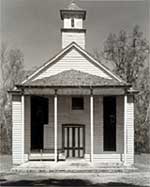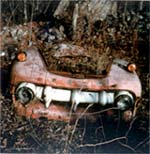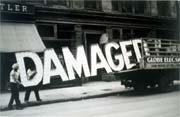
Walker Evans' photographs are easy to see--maybe too easy. The retrospective that opened this week at the Metropolitan Museum of Art in New York collects works have hung in countless exhibitions around the country over the years, and besides that, his imagery is ubiquitous. Even if you've never heard of Evans, you've seen his portrait of Allie Mae Burroughs, the Alabama sharecropper's wife with an embittered Madonna's eyes and a hardbitten lower lip. The Evans who ventured south with James Agee to do a photographic portfolio for Let Us Now Praise Famous Men and again for the Farm Security Administration during the Great Depression can be found in American history textbooks and documentaries about the 1930s, in poster stores and art bookstores, on postcards and greeting cards. Evans is our picture window onto that increasingly remote period. If it evokes the worn face of a poor white farmer, the comfortlessness of a field baked to clay in the sun, or the barren façade of a country church, well, that's how he saw it. And if your next thought is the New Deal and Roosevelt and all the political associations that go along with them, that too is not an accident.

The difficulty with Evans lies in trying to recover the original feel of these icons, underneath the various uses to which they've been put. When he first exhibited them in the late 1920s and 1930s, they must have loomed up as if out of an American blind spot, commanding immediate respect for their classical proportions but also seeming more than a little eccentric, what with that old-fashioned, proscenium-style framing and his altogether modern (and European) ambition of cataloging a side of the country usually thought unworthy of attention. Evans was an upper-middle-class Williams College dropout who put in several years as a struggling writer in Paris and New York before teaching himself photography. He lived down the street from--and collaborated with--the poet Hart Crane and hung out with editor (and New York City Ballet founder-to-be) Lincoln Kirstein and artist and fellow photographer Ben Shahn. In short, Evans was that perennial art-world oxymoron, the insider artist with an outsider sensibility. No photographer had ever brought so much obsessive rigor to the nation's detritus--our architecturally mixed-up houses and churches, our roadside stands and car dumps, the citizens we left to molder as the economy collapsed--and, as it turned out, none ever would again.
After Evans came Robert Frank, Garry Winogrand, Lee Friedlander, Diane Arbus, and their imitators. They slanted their cameras up, down, and sideways, cut everything up into fragments, and freighted those slivers of life with dark, depressed shadows and disturbing freaks. They loved America's underbelly as much as Evans did, but ironically, bitterly, with harsh condemnation for the rich and the uncaring. There has yet to appear in American visual arts another eye as tenderly, fiercely nonjudgmental as Evans'. (The closest is the documentary filmmaker Frederick Wiseman, whom I'll get to in a moment.) Evans didn't like the idea that he was making propaganda, even if he was paid by a New Deal agency. He wanted to think he wasn't pursuing anyone's agenda but his. A phrase of Agee's has become that agenda's stock explanation: "the effort to perceive simply the cruel radiance of what is."
But there is a politics to Evans' photographs. As he often wrote and told his friends, he had no use for the big ideas that dominated life in the 1930s--the socialist or the futurist utopias. Being a photographer, he gave the idea of "big idea" a visual analogue: the "beautiful" or the "perfect." Evans wasn't cynical; he just believed that nobility lay not in any grand social order but in the ordinary life of ordinary people. Evans had such passion for the world, as the Christians once said about God, that he was able to perceive in its material objects an idiosyncratic and compelling argument for the humans who made them--and that, I would maintain, is what makes his works so worth the viewing and the reviewing.

One "big idea" Evans really despised was advertising. Consider "Truck and Sign." Taken the year after the 1929 stock-market crash, the image, with its giant "Damaged" sign, can be interpreted as many of his fellow FSA documentarians' work soon would be--as a comment on the incipient Depression. But the photograph is also one in a series of meditations on a theme Evans came back to again and again, which was the impact of commercial language on the American landscape. Evans, the ex-writer, was mesmerized and appalled by the power of words to overshadow the physical. He posed his camera in front of store signs, Broadway and Hollywood marquees, and giant neon brand names, though he also looked at those from behind, from the roofs upon which they perched. On first viewing, the words trump the pictures, the words being easier to read. But then we notice the rust, the broken lights, the letters that have fallen off or not yet been put up, the men laboring like ants to put the signs up or take them down. We grasp how weather and time and chance and error have eaten away at the words' seemingly fixed meaning, tweaking it into something unexpected. "Truck and Sign" forces us to ask: What's damaged? The sign, whose lights have been removed as it is dismantled and shipped off, or the workers, dwarfed by its massive letters? The sign glows with an eerie, flat light--this is particularly palpable when you look at the Metropolitan's excellent print, a good reason to see the show if you can. The word stands out from the richly textured tones of its surroundings: the wooden storefront, the black windows, the gray sidewalk, the filthy truck. The only visual element bright enough to compete is the shirtless worker, whose muscled torso has a luminescent marble sheen as he hoists the sign onto the flatbed of the truck. In the battle of man vs. sign, man appears to be winning, for now.
Evans' subject matter has become so synonymous with contemporary notions of photographic beauty it's hard to remember how unbeautiful roadside stands and industrial landscapes must have seemed to people outside of his own tiny, avant-garde milieu. He was an aesthete, in his way. He sought out loveliness, but only in things or people beaten down, rejected, or overlooked. His rural churches, for instance, now the very incarnation of the vernacular sublime, were at the time structures few of his fellow Americans gave much thought to, except to dismiss them as cheap and vulgar. What he loved most about them, he wrote, was how time and poverty only increased their dignity: "The buildings are primitive, if the term may be used without its shade of condescension...country churches of fading, weatherworn wood, with touches of old color on the trim. ... Amplified by understatement, consecration here speaks tenfold over such labored glorifications as Saint Patrick's Fifth Avenue or the Cathedral of St. John the Divine." Lest he over-idealize these simple forms, Evans undercuts their monumentality. There's both texture (a second reason to see the pictures themselves) and a most unmonumental hint of caricature. A masklike quality to the church façade--the door hints at a mouth and the windows at eyes--sparkles through the photograph of a Beaufort, S.C., church (see above) and grows positively witty in the photograph of the Negro church that hangs next to it at the Met, with its two tiny, high-placed window-eyes. (It's instructive to compare the churches to an African mask he photographed around the same time on an assignment for the Museum of Modern Art. The job, to catalog African sculptures, was done for the money, art photography being strictly not his thing. He elicited an uncanny sense of life from the sculpture anyway.)
Here's a third reason to visit the Evans show as soon as possible: the better to understand a movie to be broadcast at 9 p.m. eastern time on PBS this Friday night. It's called Belfast, Maine, and it's by Wiseman. Wiseman may be the most rigorous adherent to the Evans worldview working in photography or film today. You either hate his method or love it: He eschews voice-overs, talking-head interviews, investigative storylines, or indeed any discernable storyline at all. But Wiseman's seemingly unobtrusive and formal gaze is a direct descendant of Evans'. Like Evans, Wiseman works hard to create the impression that he's just set up his camera and let life unfold before it, and so you should sit back and do likewise. Belfast, Maine, for instance, is a four-hour-long blinkless stare at a poor waterfront town whose rhythms, underneath a thin veneer of modern development and signage, hark back to the 19th century. The local work is processing fish and potatoes in smelly factories, farming trees, trapping and skinning coyotes, and taking care of all the people damaged by poverty. Local entertainment consists mainly of night classes in theater or drumming or choir, or else town meetings. Wiseman slices these bits of life carefully, respectfully, and clinically, as if dissecting an animal, until the whole thing roars to life in one brilliant speech given by the local high-school English teacher to his class on the subject of Moby Dick and Ahab and the brutal life of the whaler and the nature of tragedy when it strikes an Everyman. Belfast, Maine is a brutal and at times boring and in the end extremely bleak movie, but it is suffused with a powerful affection for the material details of daily life, a love we can feel in part because Walker Evans taught us how.
Photographs of: country church and Junked Car, Old Lyme, Conn., courtesy of the Metropolitan Museum of Art; Truck and Sign courtesy of Charles Cowles. All rights reserved.